Creating meaningful connections through lifestyle events requires more than just stunning visuals and clever marketing. Today’s event professionals must master the art of cultural sensitivity to build authentic relationships with diverse audiences. Recent studies show that 76% of consumers are more likely to support brands that demonstrate genuine cultural understanding, while 72% will actively avoid those that miss the mark. For event marketers and brand managers, these statistics underscore a clear mandate: cultural sensitivity isn’t optional – it’s essential for success.
PR Overview
Understanding Cultural Context in Event Design
Event branding that resonates across cultures starts with deep research and authentic representation. Major brands like Nike have shown how to do this effectively – their annual Chinese New Year collections consistently succeed by working with local artists and incorporating traditional elements meaningfully rather than superficially. This approach requires understanding the cultural significance of colors, symbols, and traditions before incorporating them into event themes.
When Pepsi launched events in Southeast Asia, they adapted their branding to include local cultural touchpoints while maintaining their core identity. Their success came from extensive consultation with local teams who understood regional preferences and traditions. This collaborative approach helped them avoid the common pitfall of simply translating existing materials without cultural context.
Preventing Cultural Missteps
Some of the most costly branding mistakes stem from insufficient cultural research. Dolce & Gabbana learned this lesson in 2018 when their Chinese marketing campaign backfired spectacularly, leading to canceled events and widespread boycotts. The incident demonstrates why thorough cultural vetting must precede any event planning.
Key areas to examine include:
- Religious and cultural holidays
- Local customs and traditions
- Color symbolism
- Dietary restrictions
- Language nuances
- Traditional dress codes
- Social hierarchies and etiquette
Building Authentic Partnerships
Successful culturally sensitive events often rely on partnerships with local communities and cultural experts. These collaborations should start during initial planning phases, not as last-minute consultations. McDonald’s demonstrates this principle well through their local market adaptation strategy, where they work with regional teams to develop market-specific events and promotions that respect local customs while maintaining brand consistency.
Measuring Cultural Impact
Traditional event metrics don’t always capture the full impact of cultural sensitivity efforts. Beyond standard attendance and engagement numbers, consider tracking:
- Social sentiment across different cultural groups
- Community feedback through cultural advisory boards
- Long-term brand perception changes
- Cross-cultural engagement metrics
- Local media coverage quality
- Community partnership sustainability
Implementation Strategies
Creating culturally sensitive event branding requires a systematic approach:
Research Phase
- Conduct cultural impact assessments
- Map local customs and traditions
- Identify potential sensitivity points
Design Phase
- Collaborate with local artists and creators
- Test concepts with target communities
- Develop culturally appropriate materials
Execution Phase
- Train staff on cultural awareness
- Implement feedback mechanisms
- Monitor real-time response
Evaluation Phase
- Gather multi-cultural perspectives
- Assess community impact
- Document lessons learned
Communication Guidelines
Clear communication stands at the heart of culturally sensitive branding. Starbucks provides an excellent example through their localized store designs and marketing materials in Asia, where they maintain their brand essence while incorporating local aesthetic preferences and communication styles.
Key principles include:
- Using clear, simple language
- Avoiding idioms and colloquialisms
- Providing multilingual materials
- Considering non-verbal communication
- Respecting local communication hierarchies
Cultural sensitivity in lifestyle event branding requires ongoing commitment and continuous learning. Success comes from building genuine relationships with diverse communities and creating spaces where all attendees feel valued and understood. Start by establishing strong cultural advisory partnerships, implementing thorough vetting processes, and maintaining open feedback channels with your target communities. Remember that cultural sensitivity isn’t just about avoiding mistakes – it’s about creating authentic connections that build lasting brand value.
Future Trends In Fintech Marketing And PR
Financial technology marketing stands at a turning point as we approach 2026, with artificial...
Personal Branding for Fintech CEOs and Executives: Building Trust and Influence
Financial technology leaders face unique challenges in establishing their professional identity....
Social Media Trends for Lifestyle Summit Success: A Guide
Social media platforms offer unmatched opportunities to promote lifestyle summits and create...



